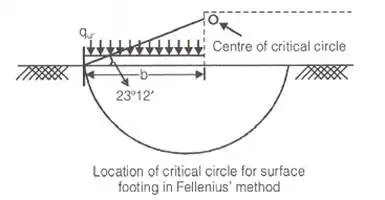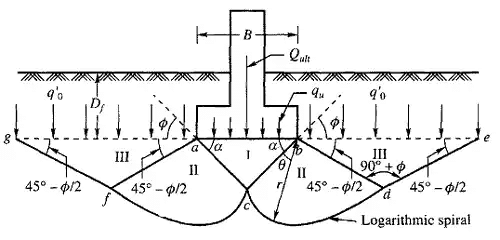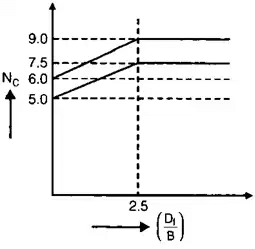Civil Engineering (CE) Exam > Civil Engineering (CE) Notes > Foundation Engineering > Shallow Foundations - 1
Shallow Foundations - 1 | Foundation Engineering - Civil Engineering (CE) PDF Download
Shallow Foundation & Bearing Capacity
Bearing Capacity
It is the load carrying capacity of the soil.
- Ultimate bearing capacity or Gross bearing capacity (qu)
It is the least gross pressure which will cause shear failure of the supporting soil immediately below the footing. - Net ultimate bearing capacity (qun)
It is the net pressure that can be applied to the footing by external loads that will just initiate failure in the underlying soil. It is equal to ultimate bearing capacity minus the stress due to the weight of the footing and any soil or surcharge directly above it. Assuming the density of the footing (concrete) and soil (γ) are close enough to be considered equal, then
qnu = qu - γDy
Where, Df is the depth of footing - Safe bearing capacity
It is the bearing capacity after applying the factor of safety (FS). These are of two types,
Safe net bearing capacity (qns)
It is the net soil pressure which can be safety applied to the soil considering only shear failure. It is given by,
qNS = qn2/FS
Safe gross bearing capacity (qs)
It is the maximum gross pressure which the soil can carry safely without shear failure. It is given by,
qs = qns + γDf
Allowable Bearing Pressure
It is the maximum soil pressure without any shear failure or settlement failure
where, qs = Safe bearing capacity.
Method to determine bearing capacity
- Rankines Method (∅ - soil)

 or
or 
- Bells Theory (C - ∅)
qu = CNc + γDfNq
where, Nc and Nq are bearing capacity factors.
For pure clays → C = 4, q = 1 - Fellinious Method: (C-soil)
(i) The failure is assumed to take place by slip and the consequent heaving of a mass of soil is on one side.

(ii) Location of Critical circle
- Prandtl Method: (C - ∅)
(i) For strip footing
qu = CNc + γDfNq + 1/2γBNγ →
(ii) For C-soil
Nc = 5.14, Nq = 1, Nγ = 0 - Terzaghi Method (C - ∅)
(i) Assumptions
S – Strip footing, S – Shallow foundation, G – General shear failure, H – Horizontal ground, R – Rough base (a) For strip footing
(a) For strip footing
qu = CNc + γDfNq + (1/2) γBNγ
(b) For square footing
qu = 1.3CNc + γDfNq + 0.4 γBNγ
(c) For rectangular footing

(d) For circular footing
where,
D = Dia of circular footing
CNc → Contribution due to constant component of shear strength of soil.
γDfNq → Contribution due to surcharge above the footing
1/2(γBNγ) → Contribution due to bearing capacity due to self weight of soil.
(ii) Bearing capacity factors
Nq = N∅.θπtan∅
where, N∅ = influence factor
Nγ = 1.8tan∅(Nq - 1)
NC = cot∅(Nq - 1)
For C-soil:
NC = 5.7, Nq = 1, Nγ = 0 - Skemptons Method (c-soil)
This method gives net ultimate value of bearing capacity.
Applicable for purely cohesive soils only.
qnu = CNc
For strip footing.
NC = 5 to 7.5
For circular and square footing.
NC = 6 to 9.0
(i) Values of NC
(a) Df/B = 0 i.e.at the surface.
Then NC = 5 For strip footing
NC = 6.0 For square and circular footing.
where Df = Depth of foundation.
(b) If 0 ≤ Df/B ≤ 2.5 for strip footing
for strip footing For square and circular footing.
For square and circular footing.
B = D in case of circular footing. for rectangular footing
for rectangular footing
(c) if Df/B ≤ 2.5 NC =7.5
for strip footing
NC = 9.0 for circular, square and rectangular footing.
- Meyorhoff's Method → (C - ∅ soil)

- IS code

The document Shallow Foundations - 1 | Foundation Engineering - Civil Engineering (CE) is a part of the Civil Engineering (CE) Course Foundation Engineering.
All you need of Civil Engineering (CE) at this link: Civil Engineering (CE)
|
18 videos|56 docs|27 tests
|
FAQs on Shallow Foundations - 1 - Foundation Engineering - Civil Engineering (CE)
| 1. What is a shallow foundation? |  |
Ans. A shallow foundation is a type of foundation that is used to transfer the structural loads from a building or structure to the ground. It is usually constructed close to the ground surface and is designed to support the load without the need for deep excavations or piling.
| 2. What is bearing capacity in relation to shallow foundations? |  |
Ans. Bearing capacity refers to the ability of the soil or ground to support the load from a structure or foundation without excessive settlement or failure. In the context of shallow foundations, it is the maximum load that the soil can withstand without causing excessive settlement or shear failure.
| 3. How is the bearing capacity of soil determined for shallow foundations? |  |
Ans. The bearing capacity of soil for shallow foundations is determined through various methods, including plate load tests, standard penetration tests, and cone penetration tests. These tests involve applying a known load to the soil and measuring the settlement or resistance to penetration. Based on these results, the bearing capacity can be estimated.
| 4. What factors affect the bearing capacity of soil for shallow foundations? |  |
Ans. Several factors influence the bearing capacity of soil for shallow foundations. These include the type and characteristics of the soil, its moisture content, the depth of the foundation, the shape and size of the foundation, the presence of any adjacent structures, and the magnitude and distribution of the load applied to the foundation.
| 5. Why is understanding the bearing capacity important in designing shallow foundations? |  |
Ans. Understanding the bearing capacity is crucial in designing shallow foundations because it ensures that the foundation can safely support the load of the structure without excessive settlement or failure. By considering the bearing capacity, engineers can determine the appropriate size, depth, and reinforcement requirements for the foundation, thus ensuring the overall stability and longevity of the structure.
Related Searches





















